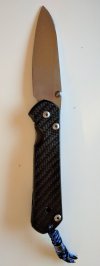This debate will never end. It's too easy to for each of us to continue to over emphasize our own points of view and the details that support it but the truth is obvious in what we're neglecting to acknowledge.
Each of our points of view seem to hinge on some ambiguous definitions.
Is it a tool or is it a piece of art?
If it is a tool and cutting is its "PRIMARY" function, then comparisons to anything else that cuts can be made. Shirogorovs ARE over priced tools but so are the other tools offered for comparison. As I said in another discussion, you can cut with a rock.
If it is a piece of art by a particular artist, then the value is truly what the market will pay for it. My Shirogorov was priced perfectly.
A Van Gogh is not compared to a Picasso to determine its appropriate value. Are the initial costs of paint, canvas, brushes and easles factored into the appropriate prices for paintings? Comparing the value of Shirogorovs to Sebenzas and Arius(es) as tools is entirely reasonable but comparing their value as art is foolish especially if you use material cost as the basis of your argument. Famous artists have in some cases reproduced their own work through mechanical or industrial processes, (silk screening comes to mind), and those reproductions, sponsored by the artist, will still fetch a premium.
Is scarcity a legitimate factor of valuation?
Spyderco PM2 Sprint runs can easily fetch 200% of their original price once they have been consumed. They are not discontinued, though no schedule for the next release is ever offered. The inflated price is driven entirely by scarcity. Scarcity is a legitimate factor in valuation.
Does anyone know how much it costs to manufacture products in Russia, for export to the United States?
What are the material costs?
Are materials imported at higher cost?
What tariffs and taxes are levied?
Are export shipments subject to losses do to corruption?
How much do CNC machines cost in Russia and do government regulations require licenses and inspections?
Ignoring any of these in your valuation devalues your opinion.
Material costs
Manufacturing costs
Business costs
Exchange rates
Competitive value
Artists reputation
Scarcity
Each of our points of view seem to hinge on some ambiguous definitions.
Is it a tool or is it a piece of art?
If it is a tool and cutting is its "PRIMARY" function, then comparisons to anything else that cuts can be made. Shirogorovs ARE over priced tools but so are the other tools offered for comparison. As I said in another discussion, you can cut with a rock.
If it is a piece of art by a particular artist, then the value is truly what the market will pay for it. My Shirogorov was priced perfectly.
A Van Gogh is not compared to a Picasso to determine its appropriate value. Are the initial costs of paint, canvas, brushes and easles factored into the appropriate prices for paintings? Comparing the value of Shirogorovs to Sebenzas and Arius(es) as tools is entirely reasonable but comparing their value as art is foolish especially if you use material cost as the basis of your argument. Famous artists have in some cases reproduced their own work through mechanical or industrial processes, (silk screening comes to mind), and those reproductions, sponsored by the artist, will still fetch a premium.
Is scarcity a legitimate factor of valuation?
Spyderco PM2 Sprint runs can easily fetch 200% of their original price once they have been consumed. They are not discontinued, though no schedule for the next release is ever offered. The inflated price is driven entirely by scarcity. Scarcity is a legitimate factor in valuation.
Does anyone know how much it costs to manufacture products in Russia, for export to the United States?
What are the material costs?
Are materials imported at higher cost?
What tariffs and taxes are levied?
Are export shipments subject to losses do to corruption?
How much do CNC machines cost in Russia and do government regulations require licenses and inspections?
Ignoring any of these in your valuation devalues your opinion.
Material costs
Manufacturing costs
Business costs
Exchange rates
Competitive value
Artists reputation
Scarcity
Last edited:










